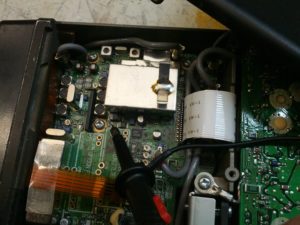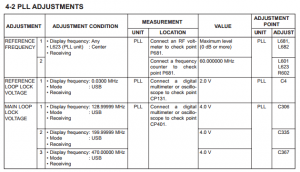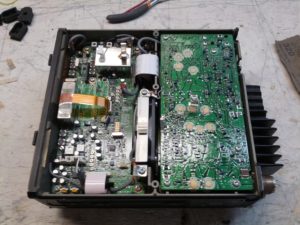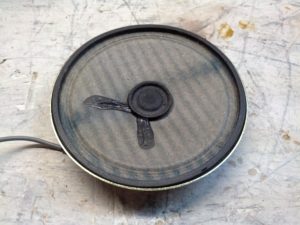Tag Archives: rig
For anyone on the Amateur Repairs (*cough* yahoo *cough*) group or who follows me on G+, YouTube, or Twitter, you’ve likely seen posts related to my IC-706 mkIIG. I’ve pulled the radio out of service because of problems primarily on VHF-FM (at least it seems that’s where the problems are at). In fact, since early December, I’ve been sporadic with transmitting with it, and I haven’t transmitted with it at all since mid-January.
The problem I’m having is extreme static even with very strong signals. I’ve checked the likely (hopeful?) culprits of power cords and antenna connections. Since things seem to be fine on those – I’ve tried two power cords and three power sources and two different antenna setups – I’ve moved on to checking internals.
My first check was for anything obvious. Like this, this, or even this. Nothing. I don’t know if I should say “fortunately” or “unfortunately”.
My second check was to poke around inside. I first looked at some of the audio waveforms at the NB test point and the WFM test point. Pretty interesting to see on a scope, and they didn’t react to volume (that’s a good thing, as this is likely before the audio amp!).
(PS in the video above: yes, I’m checking that with an oscilloscope probe. It works, even if it isn’t necessarily ‘right’… or maybe it is, I don’t know).
My second test was to do something more … practical. I know from some of the reading I’ve done in the ARRL Handbook, the owners and service manual for the rig, a video from Kenneth Finnegan (from The Life of Kenneth blog that I follow), and some comments from Mike M. on Google+ that maybe I should check the PLL board. And besides, checking stuff is easy, right?
The first check is the 60 MHz reference frequency. After finding and fixing a messed up power switch on my antenna analyzer and after checking it with the scope to ensure I wouldn’t blow up my analyzer, I probed it and found exactly 60.000 MHz. Good.
The second test was of the PLL Loop Lock Voltage. Initially, I found that it was around 300 mV. This was too far outside of the required 2.0 V at 0.03 MHz. I thought for a moment that it might be a typo, although those things NEVER happen…
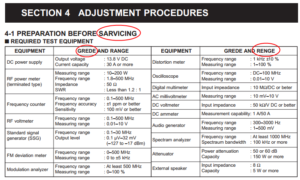
I’ve circled a few of the typos in this – not every one. Apparently I’m SARVICING this radio and I’ve been spelling GREDE and RENGE incorrectly all these years.
…and moved on to test the Main Loop Lock Voltage. It was far less than the spec 4.0 V on the first test (at 129.99999 MHz), so I didn’t continue tests.
After some replies to the post on the Amateur Repairs group, I tried again to recalibrate the PLL circuit and was able to do it. This was, of course, after I removed a shield to test two transistors. I’ve reinstalled it in the truck and so far, so good. But we’ll see. It could have been that the PLL was off causing weird errors that may have changed as voltages to the radio changed (it is mobile, after all), or it could be that something is still bad.
-73-
Update 2104-01-31
The problem came back. I tried switching out the power cable with the one I used in testing last time, and it was to no avail. At this point, I am going to do more testing to determine if this is an FM-only problem and/or if this is a VHF-only problem.
Problems
(1) Scratchy receive on 2M FM. Haven’t tested other bands or modes. Scratchy-ness sometimes goes away in a sudden fashion (like flipping a switch). It’s very much like a bad connection.
(2) Low audio volume
Potential Solutions from Research
From http://groups.yahoo.com/neo/groups/ic706/conversations/topics/17676:
Tighten chassis screws
From http://groups.yahoo.com/neo/groups/ic706/conversations/topics/14813:
“there is a known problem where the power connector is very close to a component (part of the 2m bandpass RX filter) mounted on the board. So close, that it can be knocked off the board when the power cable is plugged in or removed.”
From http://amfone.net/Amforum/index.php?topic=25009.0:
“Make sure the faceplate contacts are clean. Mine goes dead a couple times a year in my truck from this.”
From AB8SH (local friend):
Check the power connection. The Molex connector used by Icom is frequently problematic.
From unnamed (and increasingly difficult to find) posts on the IC-706MKIIG Yahoo Group:
The power connector has been mentioned multiple times on the IC-706MKIIG Yahoo Group. Additionally, the ground clips have been commonly mentioned. Frequently, these are mentioned with the 17m oscillation problem.
Reality
First thing I checked was power and ground connections. The ground clips (that should connect to the case) weren’t putting a lot of pressure on things. I bent all of them up towards the the case for good measure, although I’m not sure that fixed anything. I also ensured that all the internal screws on the PCBs were tight (all of them were).
The speaker looks aged (heck, you can see UV discoloration in the cone). Otherwise it looks fine.
After putting the rig back together, I put it on the radio bench connected to a DIFFERENT power cord and it seemed fine. A few days later, I mounted it in the truck. After driving a few miles and getting stopped at a long traffic signal, I decided to tilt the rig up more (yes, I had an appropriate Philips head screwdriver with me) and while being stopped at the light I quickly unbolted the front two mounting screws and tilted it up.
The radio died.
I (still quickly) finished bolting in the radio and while stopped at other traffic signals attempted to jiggle the power connector in the back to no avail. When I got to my destinations (another ham’s house), I found that the plug came out. In subsequent testing, it seems everything is fine.
So What Was It?
I’m banking on a bad power connection. That being said, any mobile setup should probably include proper securing of power connectors and ensuring that road vibration won’t cause things to come loose.
Edit: It is likely the power cord. I noticed static since posting this, so I’m going to replace the power cord and check the pins on the current one.
Now that I’m done cussin’ at the software (which was doing what it was supposed to, I just didn’t realize that), I have some time to reflect.
First off, 15 and 20 meters were awesome. 10 meters stunk for me – lots of calling from CA, but nobody was hearing my 25 watts from Ohio. 40 meters looked good as well. More on that in a second.
I netted 960 points in 40 QSOs. Two new DX – Cuba and the UK. One #WATwitter – @VA5LF.
I started on 20 and got several. Went to 10 (I think I got one Q there), went to 15 and tore it up. Back to 20, found a few new. Jumped to 40. On my 3rd QSO on 40 my rig quit. Just quit. I thought it had folded back (like it had high SWR). So I turned the rig off and back on. The rig lit up for a split second before dying again. Tried it again, same result. Again. Again. Put my hand on the heat sink on the back. I did NOT yell “ouch!” (or anything of the sort). It was warm, but not hot. Did the same to the power supply, and the same result. I unplugged everything and took the rig over to the bench and removed the covers. Nothing looked burned or bad, but I couldn’t see in the finals. Figuring that’s where the problem would be, I uncovered the finals. Nothing.
So I replaced the bottom cover and moved the rig aside and got the power supply. I tried to pull a pass transistor off the back, but after trying to pry it off with a knife I realized it was soldered on. So I replaced the screws on the pass transistor and plugged it back in to try and put a load on it. After plugging it in at the bench and turning it on, the transistor that I was trying to pry popped from the location I tried to pry it from.
So at least I know I have a bad pass transistor. Maybe two. The rig condition is unknown. I’m going to get a battery and hook the rig to it and see if the rig runs. I honestly don’t want to hook my Astron PS to it, as I don’t want it to blow if there is something wrong with the rig.
-73-
I am working on a Realistic (Radio Shack) HTX-100. I purchased two of these for $45 last May, and was told “one works, one does not”. I joined the HTX-HF_Tech Yahoo group and started looking into things.
The initial problem (but not the ONLY problem) was that there was a lot of static noise from the speaker. This noise was internal to the radio (thanks to a troubleshooting tip I got on Google+ that told me to short the antenna center to shield at the back of the radio).
I started poking around at things, and found that a trimmer resistor was dirty and was causing the static. Combined with the fact that the speaker was desoldered from the board (an oh-so-difficult fix!), I thought maybe I fixed it.
Then I hooked it up to an antenna and checked its ability to receive. Nothing. I could tune stations in on one HTX (and on my Ten-Tec), but not on this one. In fact, I couldn’t tune anything.
One of the things available (not only on the group but also from a few additional websites) is a repair manual, which is really very helpful. I started into the alignment procedure and noticed that in step 3, I was nowhere near the target value of 10.695 Mhz, and was not able to adjust to get anywhere close. So I started looking at the troubleshooting section for the PLL board (where the coil in step 3 was located). A few steps in the process, I checked voltages on one of the ICs and found a handful of them off. I started checking further, and questioned a crystal. I replaced the crystal and found no change. So, I started looking at other things. I checked the voltages on other ICs and found a handful of others that are off. I looked at capacitors, and noticed a few that have tears that seem to indicate that they’ve failed. I replaced one that I happen to have, and it fixed one of the voltages on one of the ICs. Progress! I have a few more to do, but I need to order the parts.
-73-
Rather than drone on about crap (literally), or new products, I figured I’d talk about what I did at the Hamvention.
My impression was just being shocked by the number of people in such a large space. The last hamfest I was at was in 2002, and there were fewer people there than at the Icom booth at Hamvention. That may be a bit of an exaggeration, but the point is made.
I originally wanted to hit four forums. I actually hit two: propagation and techniques of the best operators. They were interesting. I got there too late for 10 reasons to QRP (I already had the most important reason, and that was because I can’t afford something better!). I decided not to stay in the room for kitbuilding.
Most of my day was spent looking around the flea market. I really wanted to bring home an HF rig. After an hour or two of looking, I saw a lot of prices outside my price range, and then saw a table with a stack of two Radio Shack 10m rigs. $45 for both, one works one for parts. I couldn’t resist.
With the two rigs stuffed in my backpack, I called my wife and asked her to do some research for me. I need a power supply, since I have no intention of operating HF mobile (and I don’t think my truck can power an additional rig). She looked up the power specs and I set out in search of lunch and a power supply.
…well, power supply now, lunch later. Those are some long lunch lines.
So, I made my way around the rest of the flea market, finding a power supply for $30. Into the backpack. Those things are HEAVY.
By this time, I did stop for lunch and got into a conversation with a ham from Syracuse (I think) and originally from Minnesota. He told me about his antenna – a dipole attached to his deck eaves, something I will likely imitate once I build a deck.
Upon more looking around (and some of this, I don’t know when I saw it), I did see a cool quad antenna made with PVC (another design I will likely imitate, since I need a decent antenna for 10m now).
I also walked off with a hamstick for 10m and a handful of connectors and antenna insulators.
When I got home, I began testing things, and even though I was in less than perfect testing conditions (if you saw the wire I was using for power, you’d understand that less than perfect part). One of the rigs worked fine. The other turns on but has no display. I haven’t diagnosed it, but when I get around to it, I plan on checking it against the known mods for the HTX-100, since the speaker lines were desoldered (not cut or ripped).
So now I have the Milford Hamfest to look forward to next month.
I installed a Yaesu FT-1900R in my truck yesterday. It was quite the experience.
The first part was figuring out where the transceiver would go. After much looking and taking apart half the interior of the truck, I figured I would remove the ashtray (since I don’t smoke, it was a coin tray). I had to modify the ash tray holder and the radio mount to hold the radio mount from the sides.
The second part was actually installing the rig. Getting the antenna wire and the power leads through the firewall sucked – I ultimately pulled the grommet for the radio antenna, cut it a little (from the edge and a + in the center), got the leads through it, got it back in, and caulked the heck out of it with silicone caulk. Fortunately, with its location, I would have to be driving through a monsoon before it would leak even if I didn’t caulk it.
After all this, I placed the antenna on the hood (its a magnet mount for now, but my next change is going to be a hood mount), and went to a local park to test things out. I did hear a little bit of engine noise (I’ll have to put a filter in the power line), but I was able to hear quite well and even (somehow) picked up some guys talking about locations in California on 146.5 Mhz… it was S9.
I decided that dropping another $50 into my old Yaesu FT-411 2m HT was not the best use of my money, as I wanted to get some additional bands. So I made the trek up to R&L…
My first thought was to find an HT, since it is portable and can be carried with me on the bus. Through much discussion, I settled on a used Icom IC-T90A with no manual for $175. The unit I actually purchased had a depleted battery, so the first thing I did was plug it in. The second thing I did was download the manual from the Icom website.
I asked about a mobile rig, and found that I could get a 2m only rig (a Yaesu FT-1900R) for about $130, so I made the jump for that as well, and of course purchased a magnet-mount antenna.
Look out uhmerica! I’m back on the air.

